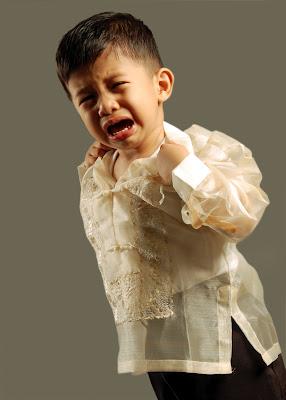
Most everyone is familiar with the term "terrible twos." A child who is 2 years old is going through emotional development that can transform a little darling into a difficult, tantrum-throwing, wild child. All children go through emotional developmental stages although some children may go through them sooner than others and the stages may be more pronounced. Last week, my son threw a tantrum at bedtime. Apparently he had decided not to sleep and would just watch TV instead. So the whole time while we were in our room he was crying, shrieking, and stamping his feet. He threw his pillows several times and when this had no effect on me he threatened to throw his pencil and books. Tantrums among children are inherent to growing up. This is their way of expressing their frustrations which, causes frustrations too among parents. Tantrums when handled properly will eventually go away. But if not, it will cause more and bigger behavioral problems among kids. How to properly handle tantrums then? First and foremost there is something that parents should always, always remember even in their midst of frustrations with their kids’ behavior. THERE IS NO INHERENTLY BAD CHILD. A child can be likened to an empty cup; he doesn’t know what is wrong and what is right yet. You, the parents are responsible in teaching your children of this. And tantrum is one very good opportunity to teach your child the demarcation line between what is acceptable behavior and not. Therefore the first thing that parents should be aware of is that never label or call the child to be misbehaving and bad. Sometimes parents, in their frustrations and in hope of making the child feel that what he has done is unacceptable, they tend to call their child names, bad names that is. They tend to label their child to be misbehaving and bad. The danger with this is that, children seeing that what they did gained their parents’ attention, they may live up the names and labels parents gave. Another thing to remember is that parents should determine first what caused the child to throw tantrums. Ask the child what is wrong, or what is it that he wants, this will help parents know how to handle the situation. Just as the case of my son’s tantrum yesterday, since I know the cause, I talked to him that he should sleep first, and after he could go back to watching TV. I explained that sleeping is important. I compared it to eating; I told him sleeping helps our body and brain develop and grow. The whole time that he was having his tantrum, I was calm and tried not to display any hint of frustration and anger. Even though he threatened to throw away his pencil and book, I just looked at him. Seeing that this action would not stir me to get mad, he eventually laid down his pencil and book. He again threw his pillow on me; I just picked it up and laid down on the table. I did it as calmly as possibly as I could. Being calm when children throw tantrums is very important. Remember, tantrums are ways for children to express their frustration, likes, and dislikes. So as parents, we ought to teach them that there are other and better ways of expressing and communicating their frustrations, likes and dislikes. Parents ought to teach them that throwing tantrums is not an acceptable behavior, and that it does not make people around them understand what they want. Definitely, parents could not explain these things to children properly if they are angry. At the same time, kids seeing their parents getting angry and mad only add up to their frustrations. Also it causes them to be confused because their parents are reacting in the same manner as they do. Thus they tend to learn that their actions are acceptable and therefore their throwing of tantrums reinforced. In situations where tantrums demand punishment, parents should never punish if they are angry. This does not apply only to tantrums but in every time a child misbehaves and punishment is necessary. Anger causes parents to punish their children unreasonably. At the same time, children seeing their parents’ anger as the reason for being punished learn violence. The real reason of the punishment, which is to teach children that unacceptable behavior comes with consequences is then clouded, and thus the opportunity for the child to learn which is right and proper from wrong and improper is lost. Tantrums again are ways for children for communication and expression first and foremost of their frustrations. For parents to be able to teach them that this is an unacceptable behavior and means of communication and self-expression, should not react in the same manner, that is with frustration and anger, to their children in this instances. How parents handle their kids’ tantrums is what they teach them as proper and acceptable behavior. ~*~ There are two things I always keep in mind in dealing with my children, which I wish to share, CHILDREN LEARN WHAT THEY LIVE, and PARENTS REAP WHAT THEY SOW.
